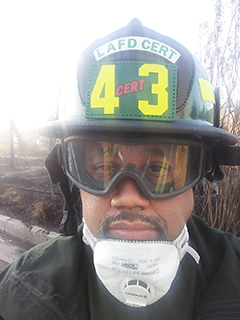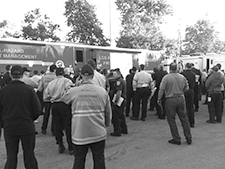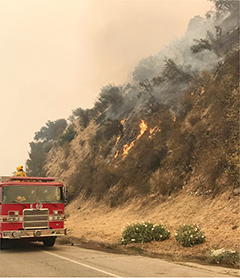A FRONT ROW SEAT to the BRUSH FIRES OF 2019
- Details
- Category: News
- Published on Wednesday, 19 February 2020 17:38
- Written by CHIN THAMMASAENGSRI
 I have served as the public safety writer for TNN and have written several articles featuring my Community Emergency Response Team (CERT). Though our central mission is disaster preparedness, some of our members serve in a "call out" position that allows us to do support work for the LAFD at incidents including these wildfires. As one of those members, I have worked on incidents dating back to the La Tuna Canyon and Creek Fires of 2017/2018 to the recent Barham Fire in the Hollywood Hills. I have seen firefighters from here and neighboring areas extinguish the "red beast" on more than one occasion. For this story, I will share with you the things I have seen during my time working these types of incidents.
I have served as the public safety writer for TNN and have written several articles featuring my Community Emergency Response Team (CERT). Though our central mission is disaster preparedness, some of our members serve in a "call out" position that allows us to do support work for the LAFD at incidents including these wildfires. As one of those members, I have worked on incidents dating back to the La Tuna Canyon and Creek Fires of 2017/2018 to the recent Barham Fire in the Hollywood Hills. I have seen firefighters from here and neighboring areas extinguish the "red beast" on more than one occasion. For this story, I will share with you the things I have seen during my time working these types of incidents.Weather has and continues to be a great predictor of what's to come, especially when it comes to our Santa Ana Winds and dry hillsides. When the Saddleridge Fire broke out on October 10, 2019, the winds blew. When The Palisades burned, the winds blew. When The Getty burned, you guessed it. On each of those days, the LAFD staffed "up" with additional firefighters, apparatus, and other resources. Each time, those resources were put into action. For the most part, fighting fire is routine, but, in the case of these fires, they rolled through in rapid succession almost weekly. Starting out, the crews were fresh and ready, but as the fires kept coming, they were tired and in need of rest. This even included crews coming from our neighboring cities such as Beverly Hills, Santa Monica, Vernon, and Culver City. Wildland crews and inmate firefighters were part of nearly all of these efforts and even they were stretched. Working a brush fire is different than working a house fire. Firefighters work in harsh conditions such as extreme temperatures, harsh landscape, and changing weather patterns.
I remember the faces of our firefighting crews as they returned to base camp after many hours in the hills and many days on duty. Food was always waiting: they ate, but there was little time to enjoy their meals. The food was usually pretty good, with a typical meal consisting of pasta, meat/sausage, salad, fruit, and water or Gatorade to wash it down.
The inmate crews were always interesting. I can tell you those men and women worked as hard as any other firefighter out there. Feeding the inmate firefighters followed a specific protocol. As servers, we DID NOT engage in prolonged conversation. Usually there was none at all. We don't give them knives, not even plastic ones, with their plates. We don't lean forward into their "space" for our own safety. Because they are doing such an admirable job, it's easy to forget that these people are serving time for crimes, but that's just the way it is. Then, you have the community outpouring of "stuff" that appears at the base camps. Though it can be problematic at times, it's wonderful to see people bring everything from personal cleansing items to giant platters of food for the firefighters and staff. What can be used really does go a long way for these tired and weary crews.
 The firefight, though, is not what we always see in the field. There is a whole strategic operation taking place where chiefs and captains are plotting the movement of the fire and coming up with strategies to stop it. They use everything from the slant of the land where the fire is burning to the dew point of the weather. Assisting them are a lot of unlikely partners like the U.S. Geological Survey, L.A. Information Technology, the U.S. Department of Forestry, and the National Oceanic & Atmospheric Administration. This reminds us that the battle is as much cerebral as it is physical.
The firefight, though, is not what we always see in the field. There is a whole strategic operation taking place where chiefs and captains are plotting the movement of the fire and coming up with strategies to stop it. They use everything from the slant of the land where the fire is burning to the dew point of the weather. Assisting them are a lot of unlikely partners like the U.S. Geological Survey, L.A. Information Technology, the U.S. Department of Forestry, and the National Oceanic & Atmospheric Administration. This reminds us that the battle is as much cerebral as it is physical.After the sun sets in the west, it is always haunting to watch a fire burn in the hillsides. I can tell you that I have watched it many times, and to the casual viewer, watching from a distance, a hill may appear rife with small "spot fires." Those spot fires MIGHT be the headlights on the helmets of firefighters working in those hills. It's always amusing when you realize it's the crews, because the random flashes become more like ant trails. I have been at the bottom of some of those areas with my partner, watching them tromp out of those hills where they have spent so many hours working. We’re there to give them “hydration” (water/Gatorade).
 If these crews are lucky, they get to return to base camp and bunk down. At Hansen Dam Recreational area, a go-to base camp spot when there is a fire in the La Tuna Canyon area, you can see military cots set up as far as the eye can see along with tents in some cases. In other cases, companies that usually handle TV and film productions have contracts and bring shower trailers, food service trailers, and sleeping quarters for the crews to use. It's quite an operation when you see it. All of this can go on for days or for weeks if needed. What we call “demobilization of the incident” takes place after “control” is called on a fire. The demobilization process is actually quick, quiet, and without a lot of glamor. The camps disappear as fast as they were built. The crews head back to their stations and, if they are lucky, they get a few days off before having to return to the grind.
If these crews are lucky, they get to return to base camp and bunk down. At Hansen Dam Recreational area, a go-to base camp spot when there is a fire in the La Tuna Canyon area, you can see military cots set up as far as the eye can see along with tents in some cases. In other cases, companies that usually handle TV and film productions have contracts and bring shower trailers, food service trailers, and sleeping quarters for the crews to use. It's quite an operation when you see it. All of this can go on for days or for weeks if needed. What we call “demobilization of the incident” takes place after “control” is called on a fire. The demobilization process is actually quick, quiet, and without a lot of glamor. The camps disappear as fast as they were built. The crews head back to their stations and, if they are lucky, they get a few days off before having to return to the grind.We’ve been lucky recently as the weather has been mostly damp and cold. That, however, lends to the growth of grass and brush which, in summer and fall, can and probably will begin the next round of brush fires for Los Angeles and the entire southwest.
